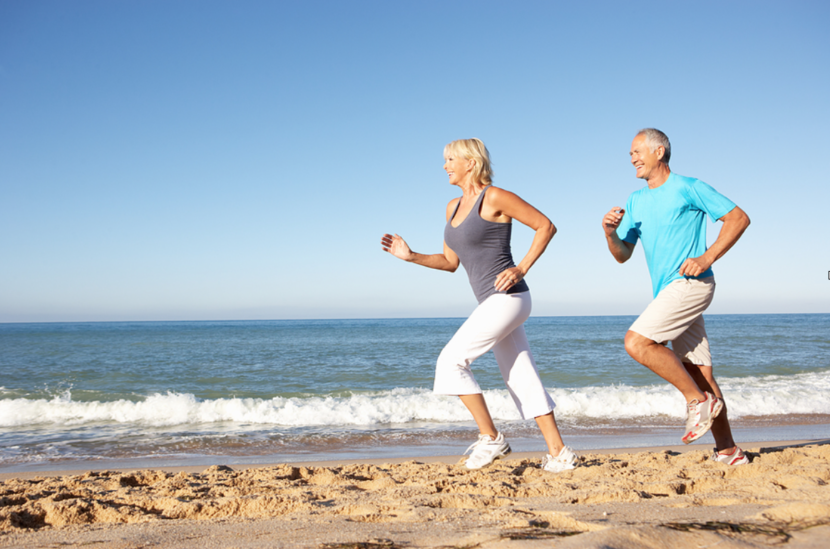While outdoor workouts are a healthy strategy, as you get some sunshine, absorb vitamin D, and naturally boost your mood, we need to take some precautions as heat and humidity rise. Follow these Warm-Weather workout tip to keep you heat smart.
- Dress appropriately. Loose-fitting polyester/cotton blend clothing or other fabrics designed to wick away moisture will help keep your body cooler. It’s not sweating itself that cools your body, but rather the evaporation of sweat. So avoid wearing clothing that soaks up sweat but doesn’t allow it to evaporate.
- Stay properly hydrated. The more you sweat, the more you’ll need to rehydrate to avoid heat cramps, exhaustion, or worse, heat stroke. Make sure to carry a bottle of water with you, and drink often. You’re better off drinking a small amount more frequently than downing a lot of water all at once.
- Avoid sports drinks and other sugary beverages though, as these will do you more harm than good. For those of you who are exercising to lose weight, you should also know that sports drinks are usually anything but low calorie. There is a perverse irony of people who are working hard exercising to burn off calories, only to be slurping down more calories and HFCS, which is linked to obesity, while they’re working out.
If you exercise for 30 minutes a day, at a moderate intensity, water is the best thing to help you stay hydrated. It’s only when you’ve been exercising for longer periods, such as 60 minutes or more, or at an extreme intensity, or on a very hot day or at your full exertion level, that you may need something more than water to replenish your body.
- To replace electrolytes lost from profuse sweating, opt for coconut water instead, which has one of the highest sources of electrolytes known to man, and can be used to prevent dehydration from strenuous exercise or even diarrhea. Be careful to restrict the coconut water to times when you are sweating profusely only, as there are plenty of sugars in coconut water, which can be a problem if you are consuming them on a regular basis when you are not sweating.
- Time your exercise to avoid peak heat. As stated in the featured article, sun, humidity and pollution levels are most intense during the midday, so to minimize the effects of the heat, work out either first thing in the morning, or in the late evening.
- Protect your skin. Apply sunscreen before heading outdoors. Another common-sense strategy to protect your skin is to wear a light-colored, loose-fitting, long-sleeved shirt and a cap.
- Go slow until your body has acclimated to the heat. Start slow, exercising in the heat for just a few minutes at a time, and gradually increase the amount of time as your tolerance builds. Again, signs of increased tolerance include breaking into a sweat more rapidly, and your sweat being more diluted or watery.
- Seek shade. Exercising in shady areas, such as tree-lined trails and parks, will help you stay cooler when the temperature rises.
- Head toward water. Any kind of water exercise is an ideal choice on a hot day as water naturally cools your body.
- Take off your shoes. Surprising as it may sound, emerging research suggests modern running shoes, with their heavily cushioned, elevated heels, may actually encourage runners to strike the ground with their heel first—a move that generates a greater collision force with the ground, leading to an increased potential for injury. The ideal location for going barefoot is the beach, or a grassy area, especially if it’s covered with dew, which is what you’d find if you exercise early in the morning.
- Remember these quick cool-off tricks. Some simple tricks to help you cool your body down include:
- Running cold water over your forearms will help reduce your body temperature. Many public areas have drinking fountains or public rest rooms where you can do this.
- Using a spray bottle, spray cool water on your skin while fanning air on it—either with a small portable fan, a paper fan, or even a towel or piece of clothing. As the water evaporates, your body temperature will drop.
- Apply an icepack or cooling neck wrap to your neck, forearms, groin, and/or armpits.
12. Team up for safety. Symptoms of heat exhaustion can come on quickly if you’re not paying attention, and since fainting is one of the symptoms, it can be far safer to exercise with a partner when the heat is on.
*source: http://fitness.mercola.com

